The creation of culture by humans has always been of interest to them, regardless of where they settled. Culture does not depend on a particular region or geography. There is no doubt that they invented unique instruments such as pump organs as a part of their culture.
Pump organs may not have the reputation they should be, but they have a rich history that you cannot deny. The portability of pump organs contributed to their popularity centuries ago compared to pipe organs.
Pump organs eventually replaced pipe organs in many wealthy households and churches. But what is the history of pump organs, and how to identify and value one? Here, you will learn about antique pump organs’ history, brand, identification, and value. So, keep reading.
Table of Contents
What Is a Pump Organ?
Pump organs are free-reed instruments where the sound comes from air passing through a vibrating metal frame. Each of these metal pieces is referred to as a reed. Pump organs, harmoniums, and melodeons are some of the specific pump organ types.
In the late 1750s, the idea of making a free-reed instrument through importation from China came to Russia. In contrast, Denmark was the first country in the west to create a free-reed instrument in 1780.
In the 19th century, pipe organs were popular in larger churches, but free-reed organs were famous in smaller churches and homes. Free-reed organs, however, were not as versatile as pipe organs in terms of timbre or volume.
Most of these instruments have a single manual, whereas pedalboards are rare. In addition to their wide range of tones, finer pump organs had beautiful cabinets fit for affluent homes and churches.
From the late 1800s to the 1920s, American and Canadian manufacturers produced large numbers of pump organs. The west produced many furniture-sized organs, but smaller models also existed.
Among the single most important instruments on the Indian subcontinent was the hand-pumped harmonium, developed by the locals to meet local needs. With an added microtone, the artisans created harmoniums that anybody could transport.
The History of Antique Pump Organ
In 1840, Alexandre Debian in France made a pump organ called a Harmonium, one of the earliest pump organs. While some experts claim authentic antiques must be over 100 years old, others consider pumps to be antiques if they date back before the Great Depression.
Due to their early manufacture between 1895 and 1910, most pump organs are now considered antiques. A pair of pedal-operated pumps produce air that powers these musical instruments.
Gratified brass reeds force air to move through the pump. Later, electric organs took over the role of pump organs, but pump organs were famous for several decades. A few musicians still use the pump organs today, but it is not as common nowadays.
By pushing air through a thin metal tube, the pump organ works. Despite its incredible sounds, pump organs have somewhat limited tones. Between 1850 and 1930, pump organs were the most popular musical instrument.
Debussy and Bach are some classic artists who used the pump organ. Mark Twain is among the most cherished writers of all time, and he made many references to pump organs in his writing. Because of their portability, pump organs became so popular at the beginning of the 20th century.
The convenience of pump organs over pipe organs made them more popular in churches. Christian Gottlieb Kratzenstein invented the first reed-free organ. He was best known for his contribution to medicine through electricity.
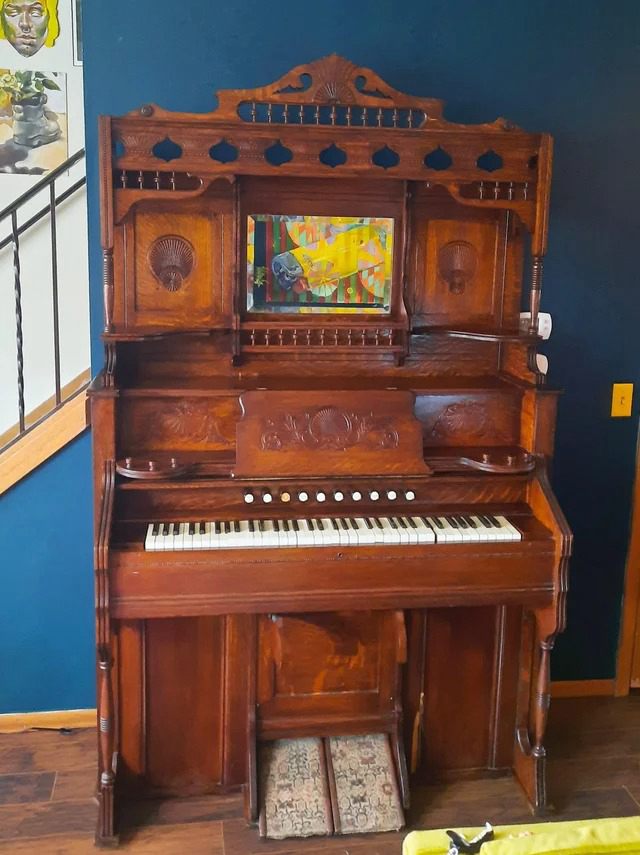
How to Identify an Antique Pump Organ?
Most people have difficulty identifying antique pump organs due to a lack of knowledge. Following are the factors that will help you identify antique pump organs easily.
Analyze the Key Tops
A key is a part of a lever system operated by the fingers, with a valve that controls airflow that activates a reed. Under the keyboard is the panel covering the reed called the key slip. The manual action of the key operates by a series of guide pins.
The key operates by using two pins per key. A pivot mount extends up and down from the rear end of the key. There is a felt-lined cavity at the front of the key where the pin sits.
It prevents the key from moving from side to side. Before 1960, the tops of almost every pump organ had ivory keys. White keys that have a hairline between the two pieces are the ones with ivory keys.
Between the two black keys is a thin piece called the “tail” of the white key. Located out in front of the black key, the “head” of the key is the flat, wide part of it. Plastic and celluloid keys have existed since the early 1880s, so there may be pump organs that still came with original plastic keytops.
Check the Wood
In contrast to antique pianos, antique pump organs were usually made out of solid wood, either walnut or oak and sold for a fraction of the price.
It was uneconomical to use veneers on pump organs at the end of the 1800s and the beginning of the 1900s. The exceptions here are the rosewood veneered melodeons manufactured in the 1800s.
Identify the Brand
If you know the brand name of a pump organ, it will become easier for you to know whether it is antique or not. I would recommend that you examine the inside of the cabinet, possibly with a flashlight, to discover the brand name of the pump organ.
There is a possibility that the name on the antique pump organ appears on sticky tags or tags. It will help if you are cautious about the name displayed above the keyboard since it may refer to a retailer or distributor, not the actual manufacturer. Remember that the brand name inside the cabinet may differ from the name on the area above the keyboard.
Locate Serial Number
If you look inside the cabinet, you will find the serial number and the brand name. A majority of the pump organ companies worldwide place serial numbers on the rear frame or panels.
In general, serial numbers on the antique pump organ get painted on using stencils, but in some cases, they were carved directly into the wood. Some companies also include printed labels on the soundboard.
It’s easier to see the label once you remove the back panel of an organ. When looking for the serial number, you want to look for five or six digits. Most construction numbers were four digits or less, which factory workers used to find out what parts went with which models.
Further, if you cannot find the serial number or brand name for the pump organ, snap some pictures of the inside and outside of the instrument. Professional organ restorers can identify these photos positively and quickly find out the organ’s manufacturer and date of manufacture using this information.
Contact Pump Organ Professional
A professional organ restorer with an organ history publication can cross-reference the serial number with the brand name to locate the manufacturing date and other information about your antique pump organ. There are many professionals available online offering restoration services for pump organs.
Send pictures and the manufacturer’s name, if you can locate it, along with the serial number and brand name to the professional organ restorer. In addition to checking references, the professional will verify all other information about the antique pump organ.
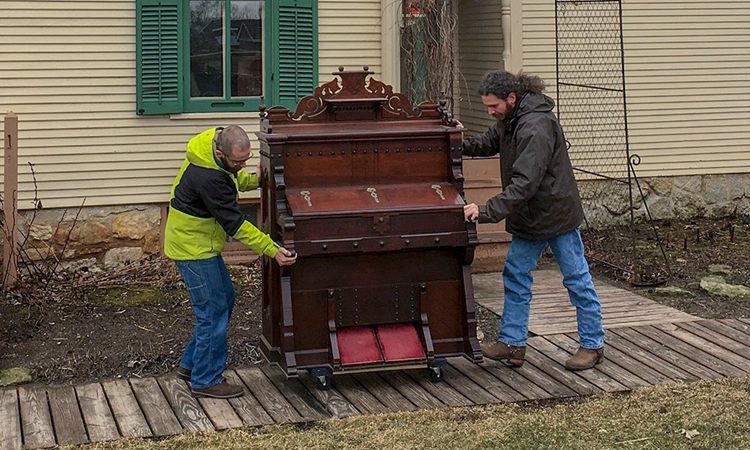
Popular Manufacturers of Antique Pump Organ
It’s always the case that a few companies dominate their respective industries, which was also the case with pump organ manufacturers.
There were 653 American manufacturers of pump organs, but only about two dozen are best known or are considered the most important. The following are most companies considered leaders in the pump organ market.
Estey
Estey was the most prominent producer of pump organs. There was a significant amount of pump organs built by them compared to any other manufacturer. Jacob Estey was the company’s founder in 1852, after purchasing another Brattleboro manufacturer.
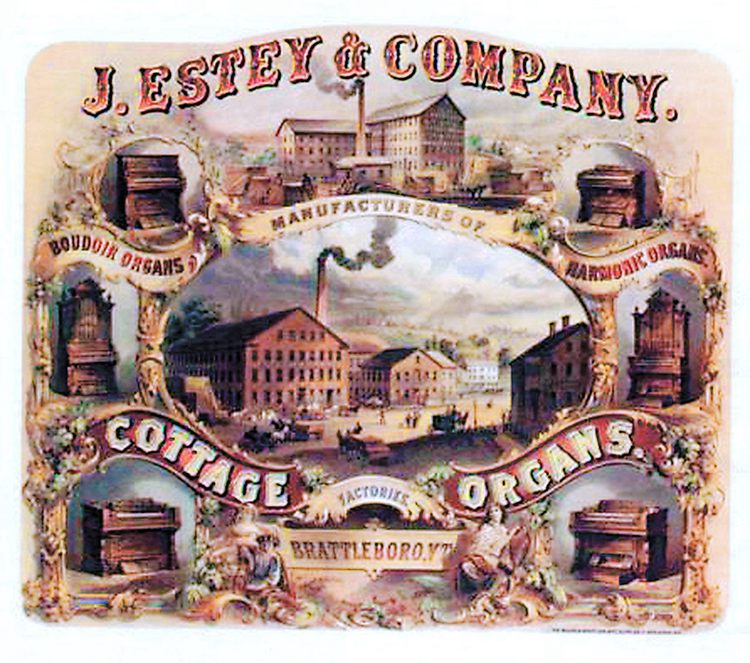
During the company’s heyday, it was one of the world’s largest manufacturers of organs, employing about 700 workers and selling high-quality pump organs all over the world. Between 1846 and 1955, Estey constructed around half a million pump organs.
Besides pump organs, Estey also produced many pianos at its New York factory. During World War II, Estey became one of the fewest companies to manufacture electronic organs.
The production of electronic organs makes it one of only a few companies to build all three types of organs: reed, pipe, and electric. It was during the 1950s that Harald Bode joined Estey. In 1951, he developed the Bode Organ, a pioneer in computing instrument research since the 1930s.
During the late 1950s, he was one of the founding members of the Estey Electronic Organ division and contributed to the development of the Estey Electronic Organ.
In 1989, Fletchers Music Centers acquired Estey Organs and began manufacturing several models for the home organ market. The home organ models came with free lessons for a lifetime. Throughout the 1990s, the company sold these exclusively through its chain of retail stores worldwide.
Carhart & Needham Company
Carhart & Needham Organ Company came into being in 1846 by Elias Parkham Needham and Jeremiah Carhart. A company known for making organs and melodeons, it garnered great success throughout its history.
Carhart, Needham & Company underwent a reorganization in 1855 after Samuel C. Swartz joined the firm. In 1865 Swartz passed away, and the name of the firm again became “Carhart & Needham.”
The pump organ lost popularity in the American home as the end of the 19th century neared as the piano gained popularity. Due to this, Carhart & Needham also shifted their focus from building pump organs toward pianos.
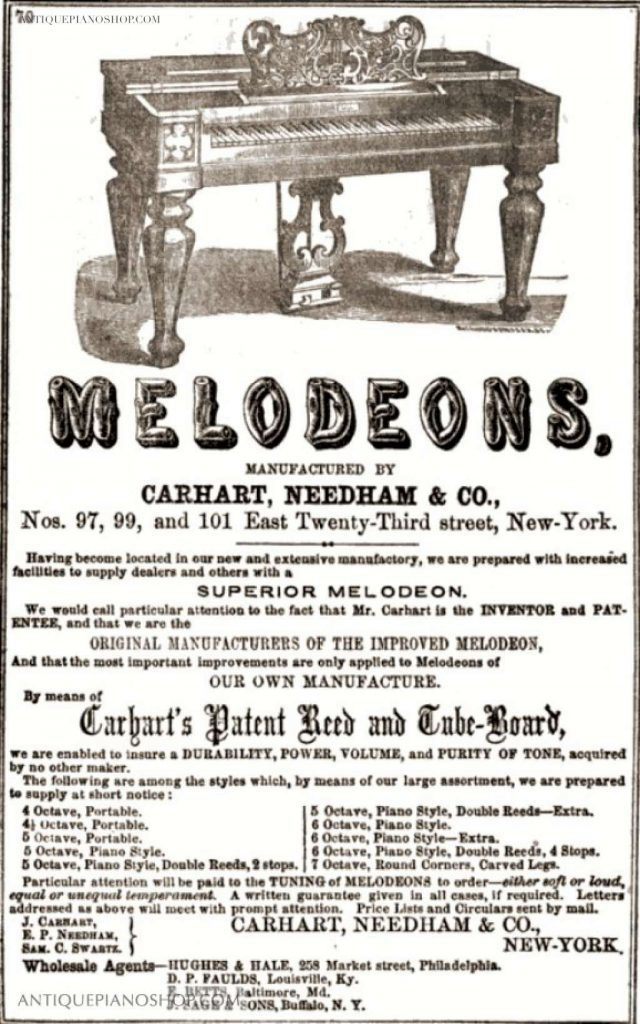
Mason & Hamlin
Mason & Hamlin is another famous company that makes pianos and pump organs based in Haverhill, Massachusetts. During the 19th century, they also produced many pump organs.
Henry Mason and Emmons Hamlin, two partners who founded Mason & Hamlin in Boston, Massachusetts, in 1854, worked together to make the brand successful.
At first, they produced only melodeons, but they introduced the flat-top cabinet organ, also known as the organ-harmonium, in 1855. The bellows were vertical beneath the reeds, making it a model for suction-operated pump organs.
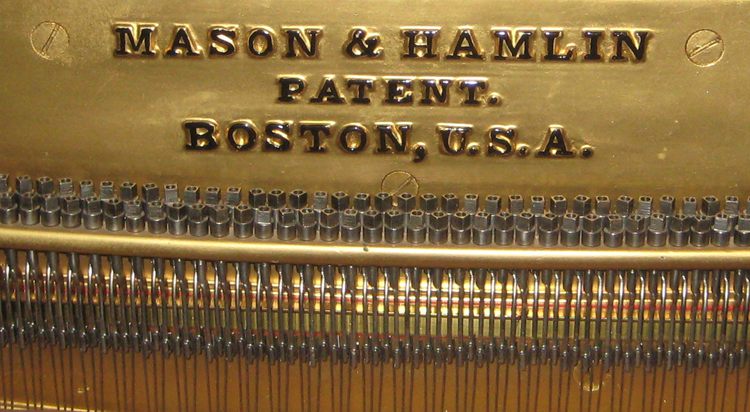
By the early 1870s, the company produced about 200 pump organs a week and employed 500 people. In addition to making pump organs for many composers, Mason & Hamlin patented a form of sostenuto similar to that found in pianos.
The company also entered the piano manufacturing business in 1883. Their first pianos were upright pianos featuring screw stringers, which they patented and marketed as an improvement over traditional tuning pin systems.
An independent German piano designer, Richard W. Gertz, completely overhauled the piano department that year, having developed new scales for them earlier.
His invention, the Tension Resonator, a device attached to the wooden structure of piano soundboards to prevent flattening of the soundboards, was patented in 1903, and he became the company’s president in 1906.
The Cable Company
Between 1880 and 1936, the Cable Company produced and distributed pianos and pump organs independently in the United States. This company, whose headquarters in Chicago, Illinois, claimed to be the largest pianos and pump organs manufacturer.
It had the distinction of being one of the largest manufacturers of pump organs for decades. In its premium Conover line, Pianos ranks among the finest. Later, EE Wise and George W Tewksbury joined the company as partners in 1885.
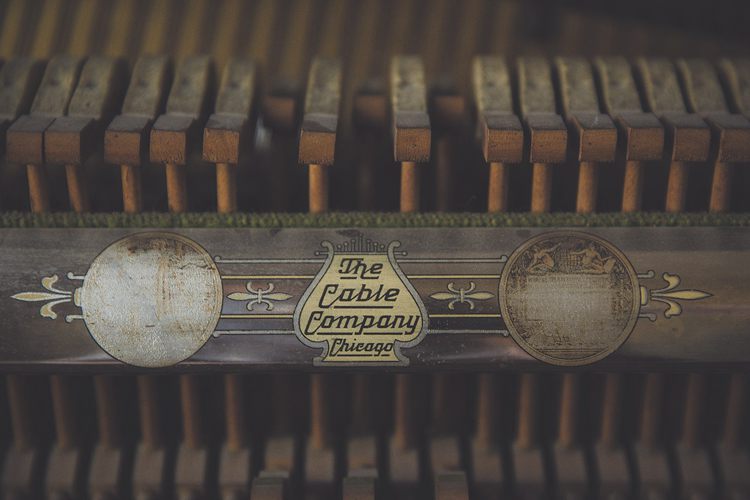
Both had worked for a company in Ottawa, Illinois, called Western Cottage. Later, Willard Naramore Van Matre joined as a shareholder and sales manager. The factory at Randolph and Ann was razed again by fire on March 12, 1886, destroying more than 2,000 pump organs under various stages of production.
Cable estimated that the damages to the stock would be $50,000, and the damages to the machinery would be $25,000. As reported by the Chicago Tribune, several firms arranged insurance for $40,550 for the company.
There were 174 employees at the company. Most of them stayed with the company as they set up temporary offices in their neighborhood. In 1887, the company purchased lots on Paulina Street and made a new plant.
Assessing Antique Pump Organ Value
Pump organs can range from a few dollars to several hundred dollars, depending on various factors. Here are a few things that can determine how valuable an antique pump organ is.
State of the Organ
The rareness and the state of a pump organ often go hand in hand. Although pump organs are rare, their current state dramatically contributes to their value. As an example, a pump organ that is rare and damaged isn’t worth the same as one that is in great shape.
As a result, if a pump organ malfunction, its value will be significantly less than if it was in perfect working order. Collectors also pay attention to many specific details when determining the condition of an antique organ. Consequently, they will not hesitate to indicate minor problems with the pump organ.
Antique collectors need to keep their antiques in a safe place when storing them. Due to their durability, pump organs are easier to handle than other instruments. However, remember that the pump organs may suffer adverse effects from their environment in some circumstances.
Uniqueness & Popularity
Antique organs are valued differently depending on their uniqueness. Large numbers of pump organs with a specific pattern and more features tend to be higher values. Rare and popular pump organs could be attractive to a lot of collectors.
Another consideration is the popularity of the pump organ on the market. It is still possible for an extremely rare piece of the antique organ to lose its value if no one wants to buy it.
If you want to sell your antique pump organ, you have to find a market with many buyers. The pump organ’s value will likely rise if demand is high enough. The concept is essentially the same as you’d find at an auction.
A person’s willingness to pay for an antique will determine its value. Therefore, if several people want the same pump organ, they might offer a high price to obtain it. Pump organs require their suppliers’ cooperation to form an antique of exceptional value.
High production of antique pump organs and their high popularity will not cause the value of an antique pump organ to rise dramatically. High popularity and limited production will cause the value of the antique pump organs to increase dramatically. It will make the pump organ the most valuable.
Compare To Recently-Sold Pieces
You can also compare the prices of vintage pump organs to see how much they are worth. If you plan on purchasing or owning anything, you need an original copy first. Comparison filters on eBay are the most effective way to compare products and know their current value.
Comparing your antique piece to those recently sold on eBay is good. Following are the current prices for antique pump organs available on eBay.
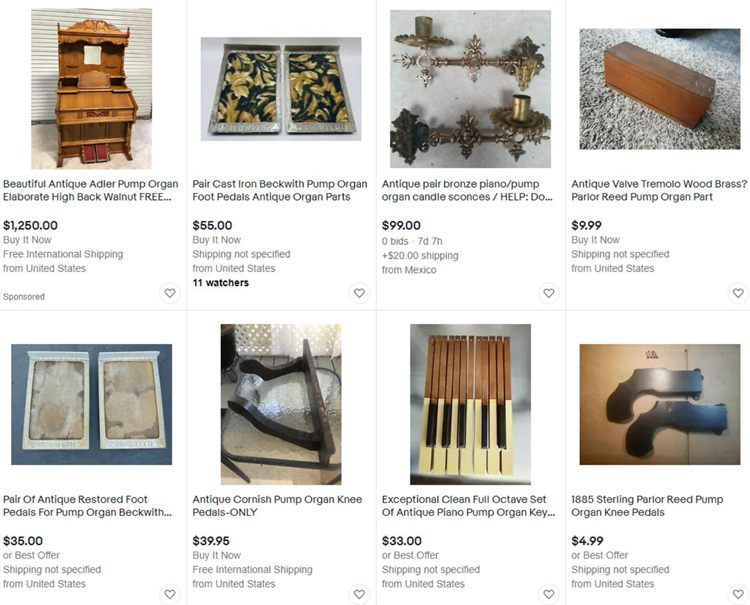
Initially, it isn’t easy to decide on the correct value for a vintage pump organ, but it becomes simple once you know all the information about it.
Price is one of the significant factors that collectors and dealers use to determine the actual worth of an item. You will ensure that the pump organs aren’t underpriced or overpriced by comparing prices.
Visit eBay, for example, if you are interested in learning more about an antique pump organ that you may have. You must select the filter according to the information you want to collect.
You will receive the knowledge to properly value and sell your antiques. Whether you are interested in selling or buying, price comparison can provide you with valuable information about the worth of your antique pump organ.
What to Do with an Old Pump Organ?
If you wish to get rid of your old pump organ, we recommend selling it. You will get a high price if you own an antique pump organ since collectors will surely be interested in buying it. It’s not always easy to sell a pump organ watch, though.
It will be best to handle antique pump organs with more care since you won’t want to sell them for less. When selling an antique, you need to take precautions. You could also contact a specialized dealer if you sell your old pump organ and are unsure what to value it.
The dealer will let you know your pump organ’s worth by examining it. The internet and in-person sales of antique pump organs help you reach a wider market for selling them. When selling your old pump organ online, carefully research the prospective seller.
Conclusion
Air flows through a vibrating metal frame in pump organs to produce sound. The harmonium was among the earliest pump organs, made in France in 1840 by Alexandre Debian.
There are several types of pump organs out there, some of which are harmoniums and melodeons. Russian artisans came up with the idea to make pump organ instruments through importation from China in the late 1750s.
Pump organs typically cost between a few and several hundred dollars, subject to various factors. It is common for the rarity of a pump organ to correlate with its state. The current state of pump organs can significantly increase the value of these rare items.
Rare but damaged pump organs are not worth as much as ones in excellent condition. The value of antique organs also depends on how unique they are. A high value typically indicates many specific patterns and features in pump organs.
Collectors are likely to be drawn to rare and popular pump organs. Another important detail that will tell you about the pump organ is its serial number. The serial number and the manufacturer’s name might be available inside the cabinet. Serial numbers appear on the rear frame or panels of pump organs worldwide.






![Vintage Schwinn Bikes: [Types, Identification, and Values]](https://www.txantiquemall.com/wp-content/uploads/2022/05/5.-Schwinn-1967-Ramshorn-Fastback-Stingray-Sky-Blue-vtg-600x450.jpg)
